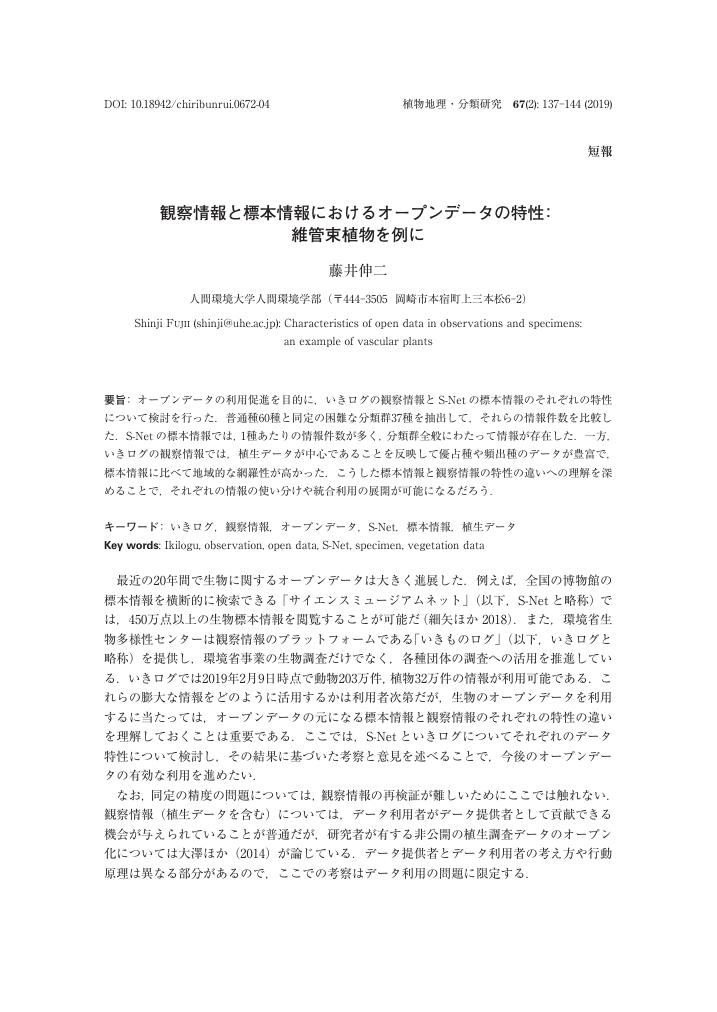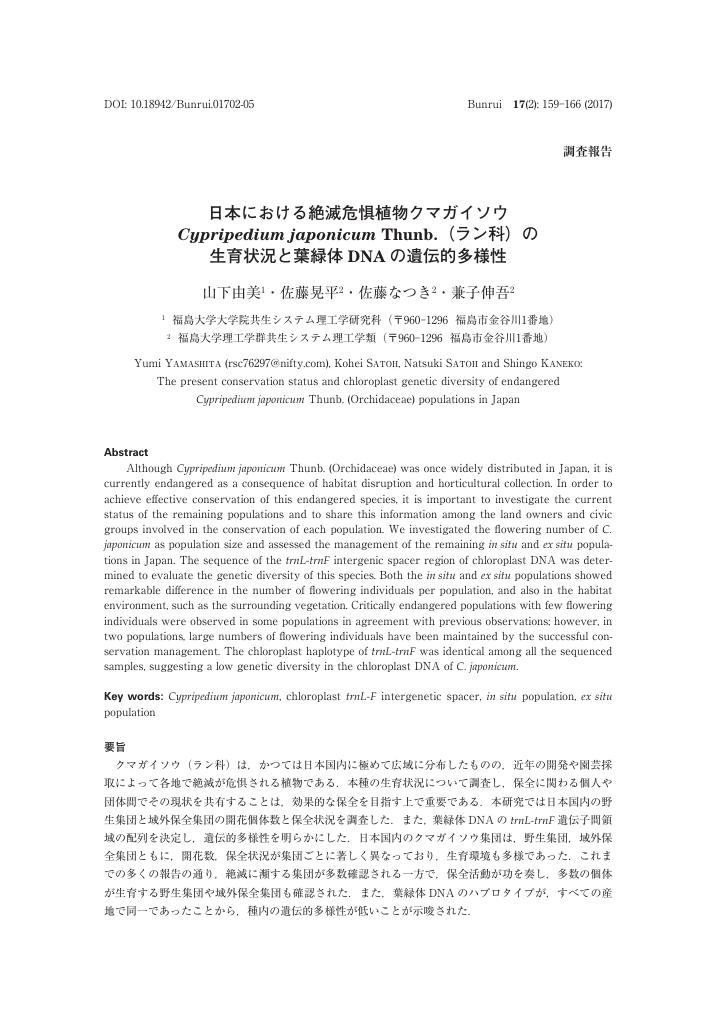4 0 0 0 OA 夜来香(ガガイモ科)の花の形態についてのノート
- 著者
- 近田 文弘 李 秉潰 吉川 佳弥乃
- 出版者
- 日本植物分類学会
- 雑誌
- 植物分類・地理 (ISSN:00016799)
- 巻号頁・発行日
- vol.40, no.1, pp.68-74, 1989-07-30
夜来香の花の構造について,特に雌蕊,雄蕊,副花冠の発生に注目して観察した。夜来香は中国南部の広東省を中心に分布しており,約10種が記載されているTelosma属のタイプ種である。夜来香は淡黄色の小花を葉腋に沢山つけるつる植物で,花には甘い香りがあり,広東省ではサラダや油炒めにして食するという。夜来香の花の形態についてはすでに著者の一人李秉滔が記載しているが,顕微鏡レベルでの固体発生は観察されていない。夜来香の雌蕊は他のガガイモ科植物と同様に二心皮性で,柱頭は大きく縦断面では台型である。胎座式は亜周辺胎座で,胚珠の数はイケマなどより多い。雄蕊先端の葯は二室性で,花粉塊はガガイモ科内では進んだ型といわれる双花粉塊となる。雌蕊と雄蕊も共に最初は指状の突起として発生を始める。副花冠は花系の背面の縦に並んだ二つの突起として発生し,花の発生の後期に急速に発達して上部が二枚に分れた弁状の副花冠となる。夜来香の花は花冠が良く発達し,副花冠や肉柱体をその花冠の中に包み込んでいるが,副花冠や肉柱体の構造は,これらが裸出しているイケマの花と同様である。
3 0 0 0 OA 植物標本デジタル画像化とOCRによるラベルデータ自動読みとり手法の開発
3 0 0 0 OA 外来水生植物オオバナイトタヌキモ(タヌキモ科)の繁殖生態: 在来種イトタヌキモとの比較
- 著者
- 野田 智祥 角野 康郎
- 出版者
- 日本植物分類学会
- 雑誌
- 植物地理・分類研究 (ISSN:03886212)
- 巻号頁・発行日
- vol.68, no.1, pp.31, 2020 (Released:2020-12-08)
3 0 0 0 OA 地域植物研究会等の現状: アンケートに基づく考察
3 0 0 0 OA 学会賞を受賞して(第9回日本植物分類学会賞受賞記念論文)
- 著者
- 瀬戸 剛
- 出版者
- 日本植物分類学会
- 雑誌
- 分類 (ISSN:13466852)
- 巻号頁・発行日
- vol.10, no.2, pp.95, 2010-08-27 (Released:2017-03-25)
- 参考文献数
- 2
3 0 0 0 OA 淡水微細藻類の採集と培養株の確立(植物分類学研究マニュアル16)
- 著者
- 仲田 崇志
- 出版者
- 日本植物分類学会
- 雑誌
- 分類 (ISSN:13466852)
- 巻号頁・発行日
- vol.15, no.1, pp.57-65, 2015-02-20 (Released:2017-03-25)
3 0 0 0 OA コカイタネツケバナ(コタネツケバナ)[アブラナ科]の 発見から記載までの経緯
3 0 0 0 OA 日本産ヒルムシロ属の雑種:研究の現状と課題
- 著者
- 角野 康郎 飯田 聡子
- 出版者
- 日本植物分類学会
- 雑誌
- 植物地理・分類研究 (ISSN:03886212)
- 巻号頁・発行日
- vol.69, no.1, pp.67, 2021 (Released:2021-12-27)
3 0 0 0 OA FTAカードを用いたフィールドでの植物DNA採集法
- 著者
- 塚谷 裕一 池田 博
- 出版者
- 日本植物分類学会
- 雑誌
- 分類 (ISSN:13466852)
- 巻号頁・発行日
- vol.5, no.2, pp.127-135, 2005-08-31 (Released:2017-03-25)
- 被引用文献数
- 1
植物分類学における分子系統学的解析が疑いなく重要となっている現在,すべての分類群を対象とした網羅的なDNAの収集がなされれば,系統分類学者にとって非常に有用なものになると考えられる.従来,遠隔地での植物DNAサンプルの採集法は,生の組織をシリカゲルで乾燥して持ち帰るというものであった.しかし,そのためには十分な量のシリカゲルを用意せねばならず,大量のサンプルを処理することは困難であった.最近,私たちはフィールド調査で植物のDNAを収集する際に, Whatman社製のFTA[○!R]カードを採用している. FTAカードにより収集されたDNAはPCR解析に向いており, DNA収集が容易で,しかもコンパクトであるという利点がある.ヒマラヤ植物研究会ではFTAカードを用いた植物DNAの収集を進めており,将来的にはこのDNAリソースを世界の研究者に提供することを目指している.具体的事例として,ロシアで行った収集について紹介する.
3 0 0 0 OA 首都大学東京・牧野標本館における所蔵標本の継続的管理と標本資料に基づく情報の発信
- 著者
- 村上 哲明
- 出版者
- 日本植物分類学会
- 雑誌
- 分類 (ISSN:13466852)
- 巻号頁・発行日
- vol.7, no.1, pp.51-56, 2007-02-20 (Released:2017-03-25)
3 0 0 0 OA 日本のモウコガマ : 兵庫県産「モウコガマ」の再検討
- 著者
- 倉園 知広 角野 康郎
- 出版者
- 日本植物分類学会
- 雑誌
- 分類 (ISSN:13466852)
- 巻号頁・発行日
- vol.12, no.2, pp.141-151, 2012-08-28 (Released:2017-03-25)
- 参考文献数
- 22
モウコガマが日本にも分布することは既に指摘されていたが,その実態については情報がなかった.本稿では,今まで「モウコガマ」とされてきた兵庫県産植物の再検討を通じて,日本産モウコガマについて考察した.兵庫県小野市産「モウコガマ」1集団とヒメガマ16集団,最近,秋田県から報告されたモウコガマ1集団について5形質を比較した結果,兵庫県産「モウコガマ」はヒメガマの変異に含まれた.一方,秋田県産モウコガマは葉身の長さと幅で「モウコガマ」とヒメガマから明瞭に識別された.モウコガマとヒメガマの識別形質とされる雌花の小苞片の有無を確認した結果,秋田県産モウコガマの雌花に小苞片は無く,「モウコガマ」とヒメガマには小苞片があった.花粉サイズを比較した結果,秋田県産モウコガマの花粉は「モウコガマ」とヒメガマの花粉よりも有意に大きく,「モウコガマ」とヒメガマの花粉サイズには差がなかった.これらの観察結果より,兵庫県産「モウコガマ」はヒメガマの変異形であり,秋田県産モウコガマは真のモウコガマであると結論した.近年,モウコガマを外来植物とする文献があるが,本種は在来種であり,絶滅危惧種として検討すべきことを指摘した.
3 0 0 0 OA Neurada procumbens(ネウラダ科)の核形態
- 著者
- 荻沼 一男 藤田 けんじろう
- 出版者
- 日本植物分類学会
- 雑誌
- 植物分類・地理 (ISSN:00016799)
- 巻号頁・発行日
- vol.48, no.1, pp.69-71, 1997-08-30
ネウラダ科Neurada属の唯一の種N. procumbensの染色体数にはいるいるな報告があった。今回サウジアラビアからの種をもとに体細胞染色体を観察した結果, 2n=14であり, これまでの報告と併せて, 属の基本数x=7を決定した。また中期染色体の核型が初めて観察された。その結果, 4本の中部型染色体, 4本の次中部型染色体及び6本の次端部染色体からなっていた。染色体長の変異は二相的であり, 染色体組中に二次狭窄を持つ染色体が2対見られた。
3 0 0 0 OA 日本産チャルメルソウ属について
- 著者
- 若林 三千男
- 出版者
- 日本植物分類学会
- 雑誌
- 植物分類・地理 (ISSN:00016799)
- 巻号頁・発行日
- vol.25, no.4, pp.136-153, 1973-03-30
- 被引用文献数
- 3
1) Thirteen Japanese species belonging to the genus Mitella (Saxifragaceae) are revised taxonomically with special reference to the morphology of flowers, the chromosome numbers, and their karyotypes. The distribution maps of all the Japanese species are given in Figs. 19-20. 2) The variation in the division of the petal was observed much greater than that reported previously even within a single species. There is a tendency of progressive reduction in the division of the petal usually in the basal portion of petal, and most extremely reduced ones are found in the apetalous flowers. This seems to be polytopic in occurrence, and any evolutionary trend can not be indicated only by this feature. 3) The chromosome numbers of Japanese species are shown in Table 2. The species with the superior ovary have 2n=14, and those with the inferior ovary 2n=28 or rarely 2n=42. 4) The karyotypes of Japanese species are shown in Figs. 4-18 and are summarized in Table 3. The two species with 2n=14 (M. nuda and M. integripetala) are distinct from each other in the karyotype and no close affinity can be found, and this is also supported from morphology. Among those with 2n=28, M. doiana, M. furusei, M. leiopetala, and M. stylosa have the chromosomes many in symmetrical form and less different in size within a single set, while the species having many asymmetrical chromosomes and those different in size within a single set are M. japonica and M. yoshinagae which are much more specialized than the formers in their karyotypes. The species morphologically specialized have not always the specialized karyotypes as seen in the case of M. doiana. 5) M. stylosa, M. furusei, M. leiopetala, M. makinoi and M. doiana are suggested to have close affinities to each other, and M. japonica, M. yoshinagae and M. kiushiana may also be speculated as that. M. pauciflora, M. acerina, and M. koshiensis remain further to be investigated, though these karyotypes resemble each other in appearance. 6) M. furusei seems to have an affinity to M. stylosa more closely than to M. koshiensis, and OHWI's proposal to reduce M. furusei to a variety of M. koshiensis should be rejected. The affinities among M. stylosa, M. leiopetala and M. makinoi are pointed out by OHWI and are supported by additional data given in this paper.
3 0 0 0 OA 観察情報と標本情報におけるオープンデータの特性: 維管束植物を例に
- 著者
- 藤井 伸二
- 出版者
- 日本植物分類学会
- 雑誌
- 植物地理・分類研究 (ISSN:03886212)
- 巻号頁・発行日
- vol.67, no.2, pp.137-144, 2019 (Released:2020-03-26)
3 0 0 0 OA 歴史ロマンも山草趣味も楽しめる植物多様性研究
- 著者
- 阪口 翔太
- 出版者
- 日本植物分類学会
- 雑誌
- 植物地理・分類研究 (ISSN:03886212)
- 巻号頁・発行日
- vol.66, no.2, pp.111, 2018 (Released:2018-12-11)
- 著者
- 中村 剛 佐藤 亜希子 小林 峻 伊澤 雅子 傳田 哲郎 横田 昌嗣
- 出版者
- 日本植物分類学会
- 雑誌
- 分類 : bunrui : 日本植物分類学会誌 (ISSN:13466852)
- 巻号頁・発行日
- vol.9, no.2, pp.159-165, 2009-08-20
- 著者
- 山田 敏弘
- 出版者
- 日本植物分類学会
- 雑誌
- 分類 : bunrui : 日本植物分類学会誌 (ISSN:13466852)
- 巻号頁・発行日
- vol.9, no.2, pp.115-121, 2009-08-20
- 被引用文献数
- 1
3 0 0 0 OA 日本植物大採集家URBAIN FAURIE師
- 著者
- 木梨 延太郎
- 出版者
- 日本植物分類学会
- 雑誌
- 植物分類・地理 (ISSN:00016799)
- 巻号頁・発行日
- vol.1, no.4, pp.315-321, 1932-12-01
- 被引用文献数
- 1

















